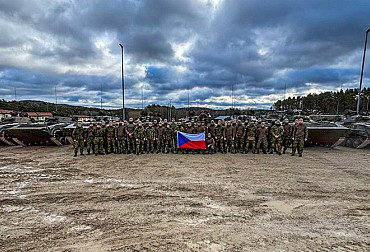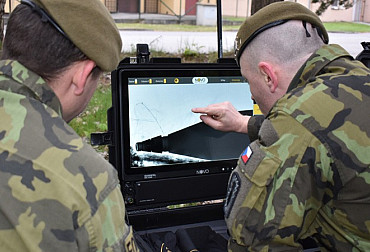The acquisition of three proven Heron drones is just the first step – the Czech Army needs many more of these assets
The announced acquisition of Heron 1 drones has brought criticism to the Ministry of Defence and the Czech Army. This is a system that made its first flight in 1994 and was introduced into the arsenal in 2005, and which, at least outside Israel, does not fly armed. It is an Israeli drone from the IAI company, and its deployment in the operations of the Israeli armed forces is naturally subject to secrecy. In late July, however, Israel released previously classified information about the system. The Israeli Herons are operationally deployed as a weapons platform with precision missiles against ground targets, and the additional information released, which was undoubtedly already available to the Czech Army and the Ministry of Defense, puts the acquisition in a much better light.
In order to avoid various speculations, we asked the Public Communications Department of the General Staff of the Czech Armed Forces and the Press Department of the Ministry of Defence of the Czech Republic whether the competent units of the Czech Armed Forces and the Ministry of Defence were informed by the manufacturer that the HERON system (or HERON 1) can be operationally deployed as a weapon platform with precision missiles against ground targets. The statement of Lieutenant Colonel Vlastimila Cyprisová from the General Staff was as follows: "The Army requires a multi-purpose unmanned system. According to the information from the supplier, the HERON-type vehicle or its modification meets all the criteria, including the configuration of sensors and weapon systems required by the Army. The specific conditions and technical parameters will be the result of negotiations between the MoD and the Israeli side, which are still ongoing. After that, a final decision will be made on the acquisition of the required system." We then received the following reply from the Ministry of Defence: "The initiation of negotiations with the Israeli Government for the acquisition of three HERON 1 drones is based on the precise technical specification of the Czech Army, which has evaluated this drone as optimal for its needs. The aim of the Ministry of Defence is to procure for the Army the equipment that it considers best for the performance of the tasks entrusted to it."
 Picture: Ministry of Defence to negotiate with the Israeli Government to acquire three Heron 1 drones, including all accessories (illustration photo) | Corporal Aaron Curran, Australian Department of Defence
Picture: Ministry of Defence to negotiate with the Israeli Government to acquire three Heron 1 drones, including all accessories (illustration photo) | Corporal Aaron Curran, Australian Department of Defence
Israel has built a reputation over two decades as an exporter of first-class military drones. But for obvious reasons, it is also a country that adheres to a strict rule of not acknowledging its own military capabilities, often even in a general sense. This keeps its enemies, both declared and potential, in a state of uncertainty and makes it difficult for them to deploy effective countermeasures. The area of drones, and particularly armed drones, is one of the most sensitive in this regard. Israel does not officially comment on their deployment and successes. From a military point of view, this is rational. However, from a commercial point of view, it is a problem, and the Israeli Government is under pressure from domestic manufacturers who face the development of foreign competition (which is often inspired by Israeli solutions). More accurate and documented references from deployment by the domestic armed forces are extremely important for the export success of weapon systems. And on 20 July 2022, the information embargo in this regard was lifted by the government, probably for this reason in particular.
Military drones are not new on the world stage. In fact, Israel purchased an armed drone – the Elbit Hermes 450, known in the military as the "Zick" (Spark) - more than 30 years ago, in 1990. Since then, it has been used in both Gaza and Lebanon. In recent years, more advanced systems, such as the IAI Heron-TP (Eitan) strategic drone, have been deployed. About 80 % of all flights carried out by the Israeli Air Force are unmanned, and these are far from being just reconnaissance or patrol flights.
Interest in these systems is growing worldwide thanks to the success of armed drones in recent conflicts, and in particular the highly publicised success of the Turkish-made Bayraktar TB2 drones in Ukraine (and before that in Nagorno-Karabakh). Export opportunities are of course key to maintaining Israel's technological edge, and supporting them by removing removable barriers is important for Israel.
Every army counts on drones today. There have been media reports of uncritical admiration that we don't need IFVs, tanks and guns, let's buy drones – for a fraction of the price we get the necessary capabilities that win wars. Drones are in fact an effective force multiplier. They need to be embedded in a 'system of systems' and the capabilities they offer need to support the means of land, air, sea and electronic warfare. In the Czech environment, for example, there has been talk of gradually replacing the subsonic L-159 attack aircraft with drones to complement the capabilities of the 5th generation supersonic fighter aircraft.
Pressure from domestic industry has prompted the Israeli Government to lift restrictions under the Missile Technology Control Regime (MTCR), which restricts the export of drones with a certain range and payload. While still adhering to MTCR standards, concerns raised by industry representatives on this issue have contributed to the fact that it is now possible to talk more openly about what the industry can offer potential customers. And the 20 July decision is also important for the content and form of the discussions in the Czech Republic.
The details of the Israeli Air Force's fleet of armed drones and the details of the missions carried out are, of course, still classified, but it is fair to say that the combination of drones with long endurance, special payloads and advanced weapons systems allows Israel to hit far and hard. Significant in this regard is the recent agreement with Germany to lease several Heron TP (Eitan) systems. The German Ministry of Defense has made no effort to hide that the goal of the acquisition is to have armed drones, and has stated that Heron has Israeli-made weapons that are capable of breaking their trajectory toward a target if civilian targets are threatened. The Bundeswehr's interest in this particular system actually arose by chance, when German soldiers themselves noticed the armed Herons during a visit to an Israeli air force base.
In April, the German Ministry of Defence declared: "With Russia's attack on Ukraine, the security situation in Europe has fundamentally changed. In order to counter the new threat, the Bundeswehr's equipment must be modernised without delay, in particular the arming of Heron drones. This need is absolutely essential, because otherwise serious national interests of a political nature would be jeopardised, and this is unacceptable." Until now, the Herons deployed by the Bundeswehr have only been used for unarmed reconnaissance. That is now changing, according to the Israeli example, on a scale commensurate with the meteoric rise in German defence spending - the acquisition of 140 armed Heron TP drones has been approved at a cost of $165 million.
The information that the Heron system is being used as a highly effective weapons platform is no longer classified. It is confirmed that the Herons are operationally deployed as a weapon platform with precision missiles against ground targets. And while we are primarily talking about the more advanced Heron TP variant, the introduction of three Heron Type 1s and associated technology and accessories can easily be followed, as in Germany, by the purchase of more Eitans. The Heron is also the most reliable UAV in its class. It has flown 500,000 hours, most of it in live operation. Among its competitors, it has the lowest losses per flight hour. The project for the Czech Armed Forces includes broad involvement of the Czech defence industry, with technology transfer to the state-owned VTU and the Pardubice-based RETIA company. Since its introduction in 2005, Heron has been continuously modernised, including the airframe and sensor equipment. And as can be seen from the German example, it has the potential for many more years of service ahead. Its massive presence in the armament of the Bundeswehr, which already has experience with this system, is then another argument for choosing these particular drones for the Czech Army.





















